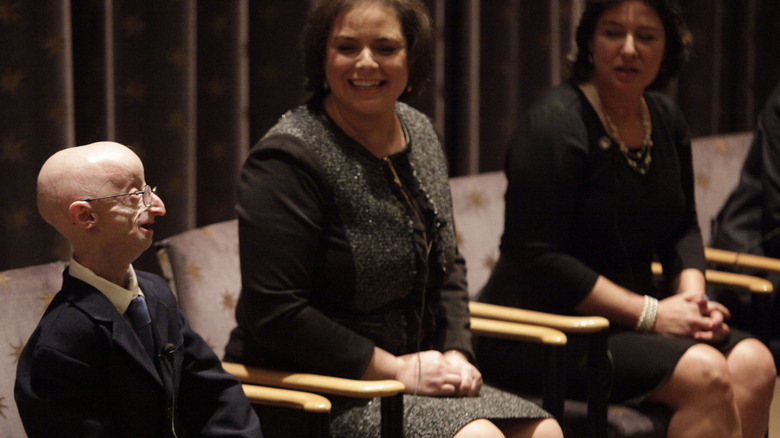The Mysterious Benjamin Button Disease That Makes You Age Prematurely
The short story and movie "The Curious Case of Benjamin Button," where a man ages in reverse, is purely fictitious — or is it? A rare genetic disease called Hutchinson-Gilford progeria syndrome actually causes a child's body to age rapidly, sometimes called the "Benjamin Button" disease, according to WebMD.
While children with this condition usually appear normal at birth and as infants, they grow slowly and fail to thrive (via MedlinePlus). It's caused by a mutation in the LMNA gene, which produces a protein that's responsible for supporting the nucleus of cells. When this protein is abnormal, it causes damage to the cell, making cells more likely to die prematurely. Hutchinson-Gilford progeria syndrome also causes the arteries to harden starting in childhood, which severely increases the chances of having a childhood heart attack or stroke.
Those with the syndrome have a distinct look, including prominent eyes, a thin, beaked nose, thin lips, a small chin, and ears that stick out (via MedlinePlus). It can also cause alopecia (hair loss), aged-looking skin, joint deformities, and loss of fat under the skin. While children's appearances change drastically, their intellectual and motor skills development are not affected. Unfortunately, most children with the syndrome do not live past the age of 13 (via WebMD).
The outlook for Hutchinson-Gilford progeria syndrome
Hutchinson-Gilford progeria syndrome is incredibly rare, affecting one in 20 million babies worldwide (via National Organization for Rare Disorders). This means that there are approximately 400 children living with the disease around the world at any given time. Since it was described in scientific literature in 1886, the Progeria Research Foundation International Progeria Registry has identified just 131 people living with the disease globally.
The condition is usually diagnosed once features become prominent, around the second year of life (via National Organization for Rare Disorders). It's diagnosed in a number of ways, including physical characteristic findings, patient history, and genetic testing. While there is no cure for the syndrome, a drug was approved by the U.S. Food and Drug Administration (FDA) to treat it in November 2020, called Zokinvy (lonafarnib), originally used to treat cancer. Other treatment includes symptom management, often involving a team of doctors such as pediatricians, orthopedists, cardiologists, and physical therapists.


